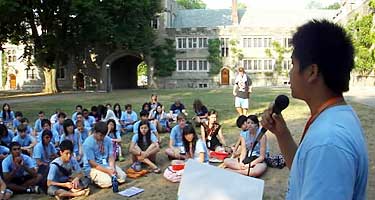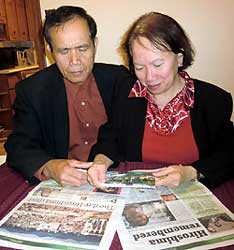 |
Three junior writers of "Peace Seeds" traveled overseas to study abroad for a short time during the recent summer vacation. They experienced life in a different culture and spent August 6 overseas, which gave them the chance to see how Hiroshima was viewed in other countries, and enjoyed conversations with host families and new friends. They reported enriching experiences. |
 USA |
Event for August 6 draws support |
 |
| Shotaro (right) leads the peace event on August 6. |
I was chosen to take part in an international exchange program for high school students and I studied in the United States for about three weeks from the middle of July. My strongest impressions involved staying in a dormitory at Princeton University in the state of New Jersey with 40 American high school students.
Before I went to the United States, I wanted to talk about Hiroshima on August 6, but I wasn't confident in my English so I almost gave up the idea.
However, I discussed it with my Japanese and American friends in the United States and they told me, "You should do it! We'll help you!" They gave me suggestions about the topic and translated my Japanese notes for the speech into English. The program staff promptly added my event into the schedule, too.
At 8:15 in the morning of August 6, local time, all 80 participants attended the event and we started with a minute of silence. Then we took part in a discussion about peace. There were a variety of ideas, such as "First, we have to try to understand each other"; "People shouldn't make war"; and "It's important to give food aid to poor countries." I was able to realize the event with the support of many people. I was so grateful for all their help. (Shotaro Takata, 16)
 Canada |
Free paper had an article on Hiroshima |
 |
| Chisa's host family looks at the article about Hiroshima and a postcard of the A-bomb Dome. |
I studied in Toronto in Canada for a month. I was awarded a scholarship from my school.
The language school where I studied in Toronto had international students from such countries as Russia, Colombia, and Spain who were about the same age as me. I told them I'm from Hiroshima, but they didn't know where it was. When I showed them a postcard of the A-bomb Dome, they asked me, "What's that?" One Canadian student was serious in asking, "The atomic bomb? Is that some kind of monster?"
I had thought that school textbooks in all countries had some description of the atomic bombing of Hiroshima. But in reality, there are many students who haven't learned anything about Hiroshima, so our history is no doubt fading.
However, on August 6, I found an article about the atomic bombing in a free newspaper in a subway station. I was happy to see that article about Hiroshima. I showed it to my host family and explained to them about the atomic bomb and Hiroshima. It was really good that I could talk about the cruelty of the bombing with my host family, beyond our nationalities. (Chisa Nishida, 16)
 ・ョ・コ |
Students listened closely to talk about A-bombing |
My junior high school has an exchange program to study abroad and I went to Auckland, New Zealand for two weeks and lived with a local family.
With my host family, I was able to make myself understood, even when I couldn't say things in English, by using gestures. For example, when they took me to the ocean, I wanted to tell them that I almost drowned when I was a small child, but I couldn't come up with the suitable English expression to explain this to them. Instead, I acted out sinking my body into water and thrashing my arms and legs. In this way, they understood what I wanted to say.
However, I experienced some confusion, too. A girl in New Zealand who had studied in Hiroshima remembered the word "shut up" in Japanese. When she talked about her memories in Hiroshima, she often used this expression "shut up," which I found puzzling.
In Auckland, the junior high school where I studied held a special gathering on August 6. I was happy to see many students listening closely to the principal's talk about the atomic bombing. (Saaya Teranishi, 14)